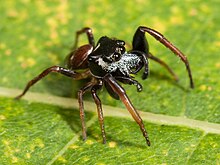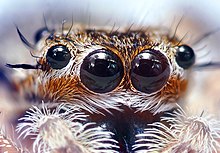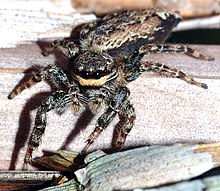Jumping spiders
| Jumping spiders | ||||||||||||
|---|---|---|---|---|---|---|---|---|---|---|---|---|

Zebra jumping spider ( Salticus scenicus ) with prey |
||||||||||||
| Systematics | ||||||||||||
|
||||||||||||
| Scientific name of the superfamily | ||||||||||||
| Salticoidea | ||||||||||||
| ??? | ||||||||||||
| Scientific name of the family | ||||||||||||
| Salticidae | ||||||||||||
| Blackwall , 1841 |
The jumping spiders (Salticidae) form the most species-rich family in the order of the web spiders (Araneae) and are at the same time the only family in the superfamily Salticoidea . Jumping spiders currently include 5862 species in 595 genera (as of May 2016). There are some not yet validated species or subspecies as well as fossil taxa that are not yet considered here. Jumping spiders are found all over the world.
Way of life
This spider family owes its name to the hunting strategy of the species belonging to it. So lurking Jumping spider on the ground or on walls and jump on their prey to them. Although they also have spinnerets , they do not use them to build spider webs , but use their silk to build egg cocoons. Some species secure themselves during their jumps with a thread made of spider silk - similar to a mountain climber - so that after a jump they can relatively easily return to the starting point by pulling themselves up again on their own thread.
When choosing their prey, the spiders use both their visual and smell senses . A prey preference and selection of the anthropophilic hunting habitat based on smell was observed in Evarcha culicivora .
Morphology and sense organs

The speed and jumping ability, which is remarkable for web spiders, is also reflected in an adjustment of the legs and tips of the legs (tarsus). The short and strong legs are hydraulically stretched in less than 18 milliseconds by increasing the hemolymph pressure . More Scopulahaare the Tarsusspitzen generate large adhesion forces so that they can begin to move up even on smooth surfaces. The majority of the rest of the spiders , the Trionycha , have three tarsal claws with which they can weave filigree webs . The Dionycha , to which the jumping spiders also belong, lack the middle claw in favor of dense scopula hair.
The quick jump also requires a change in vision. The majority of the spiders are nocturnal and very "nearsighted"; they perceive their environment more through multifunctional cleft senses and infrasound through their hair ( trichobothria ). The jumping spiders, on the other hand, have a much more developed sense of sight, which is vital for them.
In their main eyes, jumping spiders have a very highly developed sense of sight for arthropods , which allows an extended spectrum up to the ultraviolet . There are four types of photoreceptor cells ( tetrachromat ), which are also very numerous. The greatly enlarged and forward-facing main eyes have large glass bodies, which creates a long focal length. The lens focuses on the four layers of the retina, one below the other, depending on the wavelength of the light. The lower and the overlying retina are green-sensitive. However, the green image is only shown in focus on the bottom. The difference in focus between these two retinas allows distance assessment.
The retina can be moved by three pairs of muscles in such a way that the jumping spider can expand its field of vision of the main eyes and it overlaps with that of the side eyes, thus allowing spatial vision. The sharp and colored image of prey or partner is seen from a distance of more than 10 centimeters. Because it sees its prey , some species also recognize dead insects or insect eggs as food: it is easy to feed them. Phidippus audax can visually recognize its prey and conspecifics even from a distance of 20 to 30 centimeters and thus probably has the best developed sense of sight of the arachnids.
At a distance of several decimeters, her sensory organs , hair and chemoreceptors such as smell and taste serve her for orientation; with increasing proximity, the sense of sight plays a role. With this interplay, they can jump from branch to branch and from leaf to leaf, avoid obstacles and perform complex maneuvers to sneak up on their prey. The prey is jumped at from just a few centimeters away.
Mating behavior is largely determined by this visual orientation. Jumping spiders show a clear sexual dimorphism . The males often have conspicuous and bizarre formations such as brightly colored, shiny body hair, feather hair, fringes on the front legs and other signs that they show the female in courtship dance. The courtship dances are complex figures consisting of dance steps such as sideways running, zigzag movements or drumming with the pedipalps or walking legs. The latter in particular can also be observed in other spiders, which use them to generate vibrations or sound for intra-species communication . This acoustic communication has hardly been researched yet.
Species and genera

The over 5800 species are divided into at least 18 subfamilies. The World Spider Catalog currently lists 595 genera and 5862 species for jumping spiders. (As of May 2016)
Selected genera and species from Central Europe
-
Euophrys C. L. Koch , 1834
- Euophrys frontalis ( Walckenaer , 1802)
-
Evarcha Simon , 1902
- Evarcha arcuata ( Clerck , 1757)
- Evarcha falcata ( Clerck , 1757)
-
Hasarius
- Greenhouse jumping spider Hasarius adansoni ( Audouin , 1826) Cultivator in greenhouses
-
Heliophanus C. L. Koch , 1833
- Coppery sun jumping spider ( Heliophanus cupreus ) ( Walckenaer , 1802)
- Marpissa C. L. Koch , 1846
- Myrmarachne Macleay , 1839
- Pseudeuophrys Dahl, 1912
-
Saitis Simon , 1876
- Saitis barbipes ( Simon , 1868)
- Saitis berlandi ( Roewer , 1951)
-
Salticus Latreille , 1804
- Zebra jumping spider Salticus scenicus ( Clerck , 1757)
- Salticus cingulatus ( carapace , 1797)
-
Sitticus Simon , 1902
- Four-point jumping spider Sitticus pubescens ( Fabricius , 1902)
Other European species
Non-European taxa
Genera:
- Sondra (Australia)
Species:
- Asemonea cuprea (Zambia)
- Bagheera kiplingi (Central America)
- Euophrys omnisuperstes (Himalaya)
- Zygoballus sexpunctatus (North America)
- Telamonia dimidiata
Web links
Salticidae in the World Spider Catalog
- Jumping spiders of the world
- Salticidae.org - English site about jumping spiders
- Jumping spider in slow motion
Individual evidence
- ↑ a b Natural History Museum of the Burgergemeinde Bern: World Spider Catalog Version 17.0 - Salticidae . Retrieved May 1, 2016.
- ^ Fiona R. Cross, Robert R. Jackson, 2011: Olfaction-based anthropophily in a mosquito-specialist predator. February 16, 2011. Biol. Lett., DOI: 10.1098 / rsbl.2010.1233 .
- ↑ RD de Voe: Ultraviolet and green receptors in principal eyes of jumping spiders. Journal of Cell Biology , Vol. 66, No. 2, pp. 193-207, 1975. PMC 2226199 (free full text).
- ↑ Takashi Nagata et al .: Depth perception from image defocus in a jumping spider. Science , Volume 335, No. 6067, 2012, pp. 469-471, doi: 10.1126 / science.1211667 .
- ^ Gertsch, Willis J. 1979: American Spiders, 2nd edition. Van Nostrand Reinhold, New York. ISBN 0-442-22649-7 .
- ↑ Stefan Heimer and Wolfgang Nentwig: Spinnen Mitteleuropas. Verlag Paul Parey, Berlin 1991 ISBN 3-489-53534-0 .


